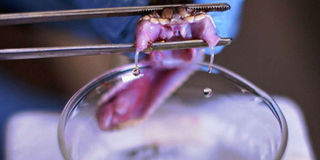Baringo County teams up with Indian firm to develop custom antivenom

An expert extracts venom from a rattlesnake at the Butantan Institute -which supplies the Ministry of Health, with many snakes' venom for its distribution countrywide- in Sao Paulo, Brazil, on November 12, 2019. PHOTO | CARL DE SOUZA | AFP
The Baringo County Government has partnered with an Indian firm to harvest anti-snake venom in a bid to address the region’s rampant snakebite cases.
The county is collaborating with Premium Serum to extract venom from local snakes and produce a specific anti-venom targeting species found in the area.
“Baringo is among the regions with the highest number of snakebite cases, and we have treated the issue as a medical emergency. We are now partnering with the manufacturer who is also training our staff on snakebite management. This programme has already started in the worst-hit areas Marigat in Baringo South and Chemolingot in Tiaty Central,” said the county's Health Executive, Dr Solomon Sirma.
The partnership allows the manufacturer to conduct intensive studies using snakes captured locally, leading to the development of effective and targeted anti-venom to be administered by trained medical professionals.
Dr Sirma expressed concern that residents in snakebite-prone regions such as Kerio Valley, Baringo South, Mogotio and Tiaty continue to suffer, with some succumbing to snakebites and others left with life-altering injuries despite ongoing interventions by various stakeholders.
The CEC noted that the ambitious project will eventually result in branded anti-venoms recommended for use by the Ministry of Health.
“Through this local harvesting initiative, the cost of anti-venom will be significantly subsidised and there will be annual donations to selected health facilities. Discussions on revenue sharing with the manufacturer from the sale of the drugs are ongoing,” said Dr Sirma.
Samples of the harvested venom will be stored at Chemolingot Sub-County Hospital in Tiaty Central for further processing.
According to Dr Sirma, health facilities in the region receive over 700 snakebite cases annually, with more than 50 fatalities.
However, due to recent interventions including staff training and improved drug availability, fatalities have dropped to about 20 over the past year.
“Most of our healthcare workers in snakebite-prone areas have been trained, and our facilities in hotspot regions are now equipped with anti-venom. However, we still face challenges with referrals. Many patients take too long to reach health facilities, and by the time they arrive, it is often too late,” he added.
Plans are also underway to equip ambulances operating in arid and semi-arid hotspot areas with anti-venom so that first aid can be administered en route to health facilities.
Local health centres have reported an overwhelming number of snakebite cases, with children being the most affected.
Prompt administration of antivenom is critical in managing snakebites. However, because venom composition varies by species and region, region-specific antivenom is required for effective treatment.
Lowland areas most prone to snakebites include Barwessa, Poi, Mugurin, Maji Moto, Bartabwa, Salawa, Endao, Lake Baringo, Kokwo, Maoi, Kapkuikui, Mukutani, Kiserian, Arabal, Marigat, Ng’ambo, Salabani and Ilng’arua.
Snakebite cases spike during dry seasons as snakes stray into homesteads in search of water.
According to the World Health Organisation (WHO), snakebite is classified as a neglected tropical disease.
Globally, an estimated 5.4 million people are bitten by snakes each year, with around 2.7 million of those involving venomous species.
These bites result in more than 100,000 deaths and leave approximately 400,000 survivors with lifelong disabilities or disfigurements.


